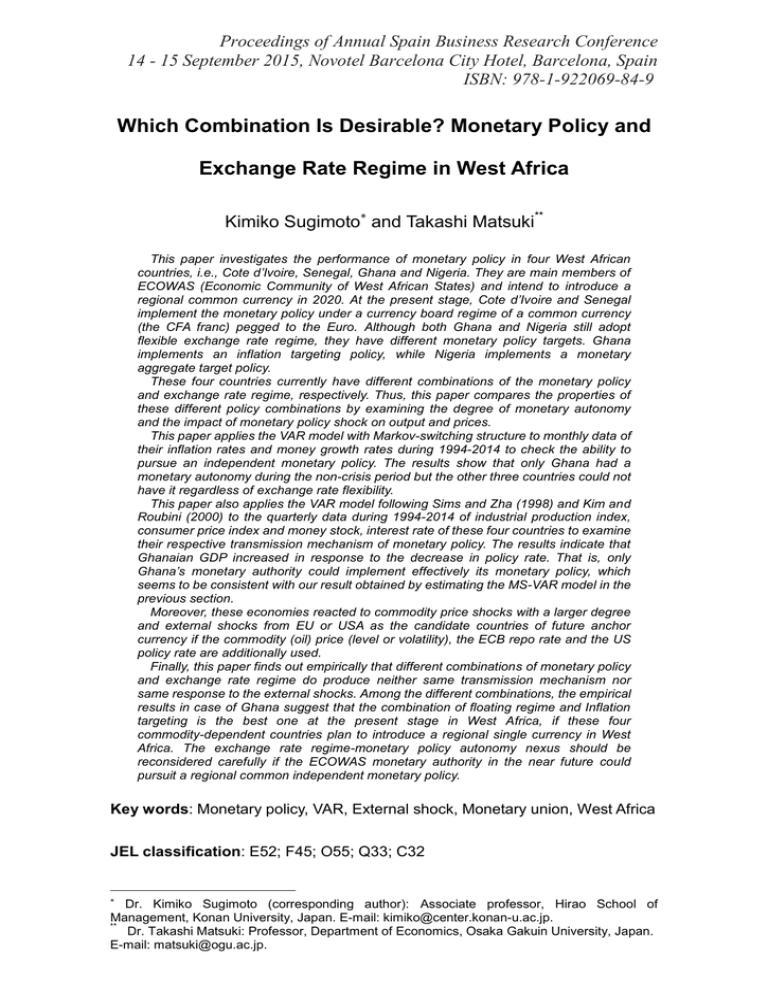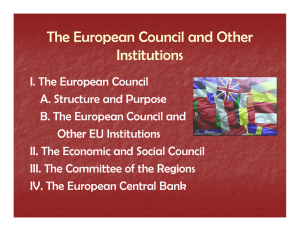Proceedings of Annual Spain Business Research Conference
advertisement

Proceedings of Annual Spain Business Research Conference 14 - 15 September 2015, Novotel Barcelona City Hotel, Barcelona, Spain ISBN: 978-1-922069-84-9 Which Combination Is Desirable? Monetary Policy and Exchange Rate Regime in West Africa Kimiko Sugimoto and Takashi Matsuki** This paper investigates the performance of monetary policy in four West African countries, i.e., Cote d’Ivoire, Senegal, Ghana and Nigeria. They are main members of ECOWAS (Economic Community of West African States) and intend to introduce a regional common currency in 2020. At the present stage, Cote d’Ivoire and Senegal implement the monetary policy under a currency board regime of a common currency (the CFA franc) pegged to the Euro. Although both Ghana and Nigeria still adopt flexible exchange rate regime, they have different monetary policy targets. Ghana implements an inflation targeting policy, while Nigeria implements a monetary aggregate target policy. These four countries currently have different combinations of the monetary policy and exchange rate regime, respectively. Thus, this paper compares the properties of these different policy combinations by examining the degree of monetary autonomy and the impact of monetary policy shock on output and prices. This paper applies the VAR model with Markov-switching structure to monthly data of their inflation rates and money growth rates during 1994-2014 to check the ability to pursue an independent monetary policy. The results show that only Ghana had a monetary autonomy during the non-crisis period but the other three countries could not have it regardless of exchange rate flexibility. This paper also applies the VAR model following Sims and Zha (1998) and Kim and Roubini (2000) to the quarterly data during 1994-2014 of industrial production index, consumer price index and money stock, interest rate of these four countries to examine their respective transmission mechanism of monetary policy. The results indicate that Ghanaian GDP increased in response to the decrease in policy rate. That is, only Ghana’s monetary authority could implement effectively its monetary policy, which seems to be consistent with our result obtained by estimating the MS-VAR model in the previous section. Moreover, these economies reacted to commodity price shocks with a larger degree and external shocks from EU or USA as the candidate countries of future anchor currency if the commodity (oil) price (level or volatility), the ECB repo rate and the US policy rate are additionally used. Finally, this paper finds out empirically that different combinations of monetary policy and exchange rate regime do produce neither same transmission mechanism nor same response to the external shocks. Among the different combinations, the empirical results in case of Ghana suggest that the combination of floating regime and Inflation targeting is the best one at the present stage in West Africa, if these four commodity-dependent countries plan to introduce a regional single currency in West Africa. The exchange rate regime-monetary policy autonomy nexus should be reconsidered carefully if the ECOWAS monetary authority in the near future could pursuit a regional common independent monetary policy. Key words: Monetary policy, VAR, External shock, Monetary union, West Africa JEL classification: E52; F45; O55; Q33; C32 Dr. Kimiko Sugimoto (corresponding author): Associate professor, Hirao School of Management, Konan University, Japan. E-mail: kimiko@center.konan-u.ac.jp. ** Dr. Takashi Matsuki: Professor, Department of Economics, Osaka Gakuin University, Japan. E-mail: matsuki@ogu.ac.jp.






